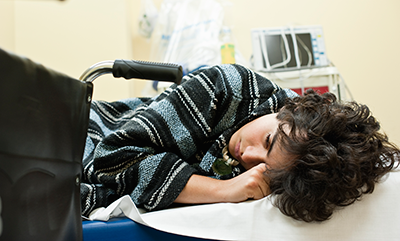Health Promotion Advocates Help Intervene in Pediatric ERs.
 Almost 200,000 adolescents visit US emergency departments yearly for conditions related to underage drinking or other risky behaviors but receive no follow-up referrals. A pilot program that puts “Health Promotion Advocates” into the emergency room to conduct brief screenings of patients’ risks, stresses, and needs and to offer referrals is useful in steering adolescents to resources and treatments, says a new study by a team from the School of Public Health, Boston Medical Center, and the School of Medicine.
Almost 200,000 adolescents visit US emergency departments yearly for conditions related to underage drinking or other risky behaviors but receive no follow-up referrals. A pilot program that puts “Health Promotion Advocates” into the emergency room to conduct brief screenings of patients’ risks, stresses, and needs and to offer referrals is useful in steering adolescents to resources and treatments, says a new study by a team from the School of Public Health, Boston Medical Center, and the School of Medicine.
In the study, published in the journal Pediatric Emergency Care, researchers led by Judith Bernstein and Edward Bernstein, who hold appointments as professors of community health sciences at SPH and emergency medicine at MED, and their colleagues report on the use of Health Promotion Advocates (HPAs) to help to steer at-risk adolescents to care and services. From 2009 to 2013, HPAs screened 2,149 pediatric patients ages 14 to 21 and referred 834 for an array of services, such as primary care, mental health, insurance, personal safety, and HIV testing. Of those screened, 785 were found to be at risk for substance use. Six hundred and thirty-six received a brief intervention; 546 were referred to specialized substance abuse treatment.
Judith Bernstein said the model was effective in identifying risk behaviors and unmet needs and guiding young people to services. She said working with adolescents has a different focus than with adults, who may already be on the road to a substance use disorder.
“Pediatric EDs have a ‘window of opportunity’ that might otherwise be missed to screen for high-risk behaviors, negotiate change, and provide supportive community resources that can help set a pattern for healthy adulthood,” she said. “Health Promotion Advocates working as part of the PED team can be a way to extend services beyond the scope of the presenting complaint, during the critical, transformative time of adolescence.”
Bernstein said the team has found that “the best approach is to provide resources and services that address all the complex determinants of risk, rather than focus solely on substance use. We refer teens to GED programs, assess safety at home, offer prescriptions for food pantries, test for HIV, and refer to behavioral health.”
The American Academy of Pediatrics recommends that all adolescents be screened for substance abuse, emotional well-being, risk reduction, and violence and injury prevention as part of their regular health care maintenance. But adherence to this recommendation has been low, and adolescents have one of the lowest rates of primary care use among all age groups in the US. As a result, adolescents rely on EDs for both urgent and non-urgent care at a higher rate than any other age group, the authors said.
The Health Promotion Advocates are needed because clinical teams in the ED are often short-staffed for meeting basic needs, “and prevention efforts cannot be sustained by asking busy staff to ‘do just one more thing,’” Bernstein and colleagues said. Pediatric social workers are skilled in making assessments and referrals when adolescents with high-risk profiles are identified, but they often are occupied with the most complex patients, especially victims of violence, neglect, and abuse.
“Additional trained designated personnel are needed in PEDs to realize the opportunity to engage adolescents in prevention,” the authors argue.
Among the challenges of the program were integrating the advocates into the existing clinical setting and establishing “buy-in” from medical staff, Bernstein and colleagues said.
“When our research studies first started, convincing staff that prevention-based services within the PED were not only appropriate but could be helpful to staff as well as patients proved difficult. Educating staff about the services the program could provide was essential,” they said.
“Once clinicians saw the range of services provided, they were won over. It became clear to most attending physicians and nurses that the HPAs were offering important care that we would not otherwise provide,” Bernstein said.
Over time, the Health Promotion Advocacy Program has been successfully integrated into clinical care. It is now a line item in the hospital budget and is implemented under the direction of Pearl Cunningham, BMC’s clinical director of emergency medical services, and Ellen Kreida, who supervises an internship for SPH students.